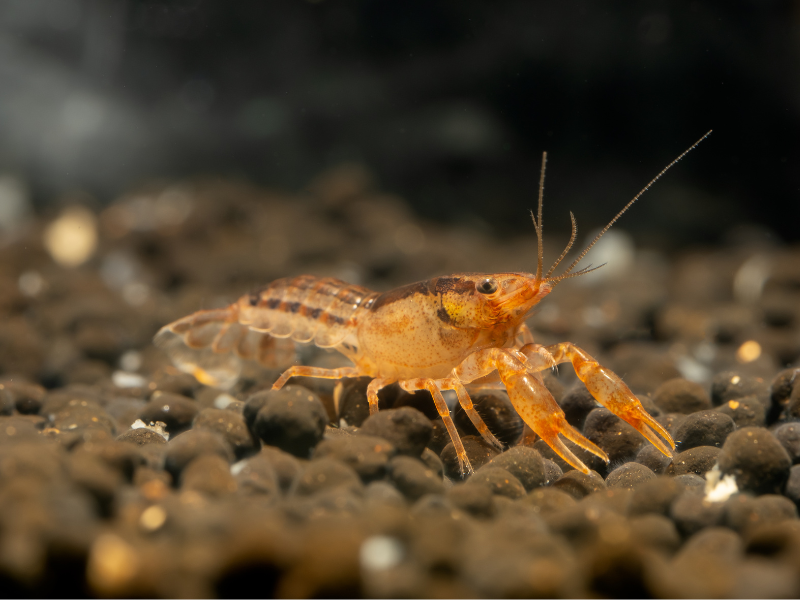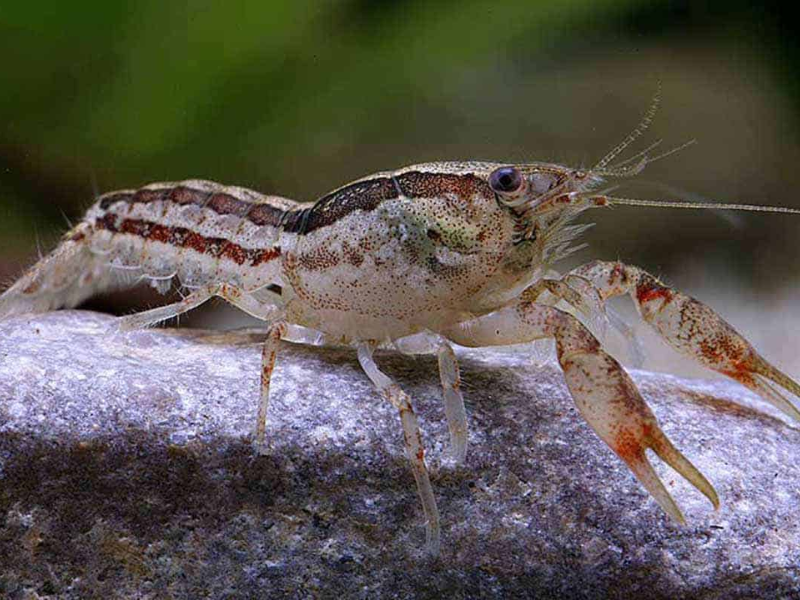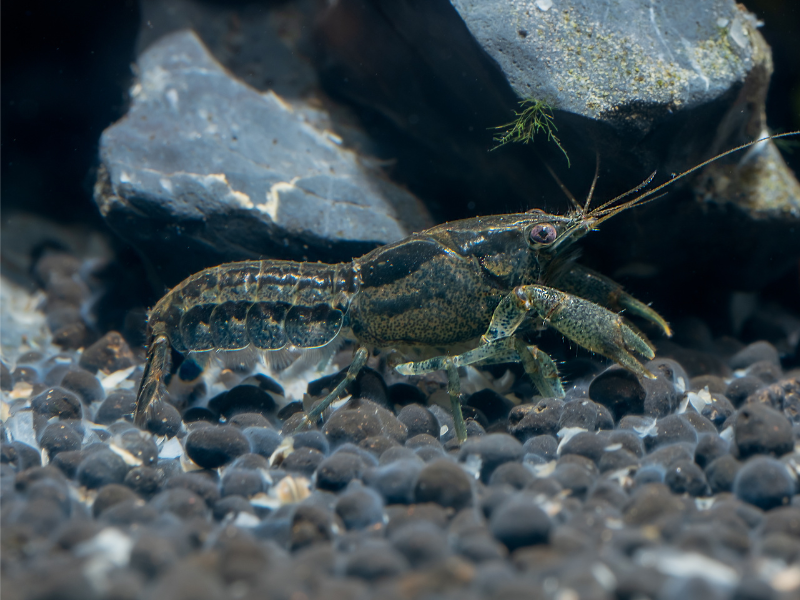Cambarellus patzcuarensis
Mexican Dwarf Crayfish

Scientific Classification
Quick Stats
Aquarium Building Information
About This Species
Basic Description
Detailed Description
The Mexican Dwarf Crayfish, Cambarellus patzcuarensis, is a fascinating invertebrate from North America that has gained popularity for its manageable size and engaging behavior. Unlike its larger, more aggressive relatives, this species can be integrated into certain community aquariums with careful planning. To provide the best care, it's beneficial to replicate its natural environment. These crayfish prefer aquariums with gentle water movement and stable, clean water within a moderate temperature range. A substrate of sand or fine gravel is ideal, allowing them to exhibit natural foraging behaviors.
An aquascape rich in structure is paramount for their well-being. They are territorial creatures, and a complex layout with rocks, caves, driftwood, and dense plantings helps to establish boundaries and reduce aggression, especially in a group setting. These structures provide essential hiding places where the crayfish can retreat, feel secure, and safely undergo its molting process. While they are known to consume biofilm, they may also nibble on or uproot delicate, soft-leaved plants, so harty species are a better choice. A secure, tight-fitting lid is non-negotiable, as their innate curiosity and climbing ability make them skilled escape artists.
A varied, omnivorous diet is crucial for their health. A high-quality sinking pellet or wafer designed for invertebrates should form the basis of their diet, ensuring they receive necessary minerals for exoskeleton development. This can be supplemented several times a week with blanched vegetables, and protein-rich frozen or live foods. Their role as detritivores is also noteworthy; they will scavenge for leftover food and organic debris, contributing to a cleaner tank. Careful attention to water hardness is important, as sufficient calcium and other minerals in the water column are vital for successful molting, a vulnerable and critical process for their growth.
In a community setting, tank mates must be chosen with care. Avoid other bottom-dwelling species that may compete for territory. Extremely small shrimp or fish may be viewed as a potential meal. The best companions are small, fast-moving fish that inhabit the middle to top levels of the water column. Due to their low waste production and oxygen needs, they add minimal bioload to an established system, but their territorial nature remains the primary consideration for housing.
Scientific Description
Cambarellus patzcuarensis is a decapod crustacean belonging to the family Cambaridae, a group predominantly found in North America. Its classification places it within the genus Cambarellus, which comprises several species of dwarf crayfish. Morphologically, this species exhibits a depressiform body shape, a dorsoventral flattening that is an adaptation to its benthic existence, allowing it to navigate confined spaces within the substrate and rocky crevices. As a decapod, it possesses five pairs of pereiopods (walking legs), with the first pair modified into chelipeds (claws), and an abdomen equipped with pleopods (swimmerets) for locomotion and, in females, for brooding eggs.
Physiologically, C. patzcuarensis is characterized by a low metabolic rate, corresponding to low oxygen consumption and waste production. This makes it suitable for smaller, stable aquatic ecosystems and results in a minimal bioload factor within a closed system. It is a strictly freshwater organism with very limited tolerance for salinity. Its dietary classification is omnivorous, functioning ecologically as a detritivore and a consumer of biofilm. In its natural habitat, it plays a role in nutrient cycling by breaking down organic waste and consuming decaying plant matter.
From a conservation standpoint, the species is listed as Endangered on the IUCN Red List. Wild populations, endemic to a specific lacustrine environment in North America, face significant threats from habitat degradation, pollution, and the introduction of non-native species. This precarious status underscores the importance of sourcing captive-bred individuals for the aquarium hobby to prevent further pressure on wild stocks. The study of its behavior in captivity reveals a moderately active animal with pronounced territorial instincts, a key consideration for its husbandry and for understanding its social dynamics.
Breeding Description
Breeding the Mexican Dwarf Crayfish is considered a moderately challenging but rewarding endeavor. Success hinges on providing a stable, optimized environment and properly conditioned adults. A dedicated breeding tank is highly recommended to maximize fry survival, as adults may predate their young in a community setting. This tank should be equipped with gentle filtration, such as a sponge filter, which prevents the tiny fry from being drawn in. A complex environment with abundant hiding places like cholla wood, rock piles, and dense mosses (e.g., Java moss) is crucial. These structures not only offer refuge for the vulnerable fry but also cultivate biofilm and microorganisms, which serve as their essential first food source.
Distinguishing between sexes is a key first step. Males can be identified by examining their first pair of pleopods (swimmerets), located on the underside of the abdomen where it joins the thorax. In males, these are modified into hardened, L-shaped appendages called gonopods, which are used to transfer sperm. In females, all pleopods are soft, feathery, and uniform in appearance. For a successful breeding colony, it is advisable to maintain a ratio of one male to several females, which helps disperse the male's mating pursuits and reduces stress on any single female.
To encourage breeding, condition the adults with a diet rich in protein and calcium. Supplementing their staple diet with frozen and live foods can trigger spawning behavior. The male will initiate mating by flipping a receptive female onto her back to deposit his spermatophore. Following successful fertilization, the female will retreat to a secluded area to lay her eggs. She then attaches the clutch of eggs to her pleopods, a state commonly referred to as being "berried." The female will meticulously care for the eggs, constantly fanning them with her swimmerets to provide oxygen and prevent fungal growth. After several weeks, the eggs will hatch into fully formed, miniature versions of the adults. The fry may remain with the mother for a short period before venturing out on their own. At this stage, they are self-sufficient, grazing on biofilm and finely powdered foods. Providing extensive cover is paramount, as the fry are prone to cannibalism during their vulnerable early stages.
Generate Printable Card
Create a printable card for this creature to display in your store or aquarium. The card includes a QR code for quick access to more information.

